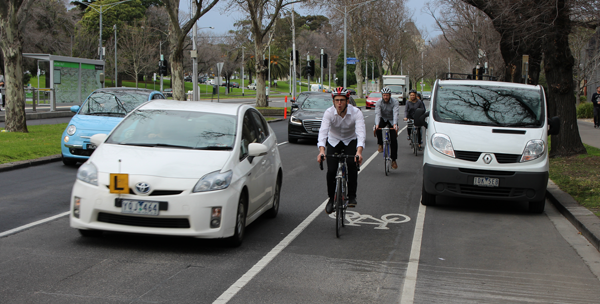When we think of other road users as people rather than as cyclists, pedestrians, motorcyclists or drivers, we will make real progress towards solving road rage. Ian Munro reports.
There was a time when motorists passing one another on a country road would acknowledge each other with a casual wave. It was partly polite greeting, partly relief that we were not entirely alone on a lonely road. But underlying it was acknowledgment of a common self-interest.
Cars were less reliable then. Mobile phones did not exist. If you needed to call for roadside assistance you hoped for a passing Samaritan to pull over and offer a lift to the nearest telephone at least, if not the closest town.
Now there is not that sense of mutual vulnerability. With a mobile phone who needs a Samaritan? Instead, with increasing congestion on the roads everyone is an obstacle. It’s often every driver, rider or cyclist for him or herself with little regard for the needs of others.
“We in Australia are one of the most competitive driving countries in the world,” Geoff Thomas, managing director of Murcott’s Driving Excellence says. “In Victoria we don’t have a high level of co-operation. There’s a high level of competition. We have people who are judgmental, and once they judge the other person as at fault they don’t behave in a tolerant manner towards them.”
A few years ago during a spike in the motorcycle road toll a Melbourne daily newspaper published a letter from a driver who thought the cause of the toll lay in his observation which was that “all motorcyclists speed”. The driver based his statement on the fact, he wrote, that the only motorbikes he saw on the freeway during his commute were overtaking him as he travelled at the legal speed limit.
The letter was a classic example of how people categorise and stigmatise others whom we perceive as different to ourselves. Once an association between a type of behaviour and a category of person is made, people tend to generalise about that group. And the more a particular group stands out—say cyclists compared to motorists or, older compared to younger drivers—the easier it is to make that association.
The best drivers … can tolerate the mistakes of other road users
Professor Nick Haslam of the Melbourne University School of Psychological Sciences says that once an opinion is formed we tend to seek information that confirms it, and disregard anything that contradicts it.
“It’s called confirmation bias. If you think all four wheel drivers are intimidating or do this or that, you are primed to see it,” Professor Haslam says. “When these beliefs are formed they are resistant to change. We tend to find, and we tend to pay more attention to those things that confirm our beliefs. They can be self-fulfilling. If you have a negative view of a certain kind of road user, your interaction with them may be hostile.”
But, he says, it is unsurprising people hold strong views because the road can be “a zone of conflict (where) everyone is a potential danger to us. There are real objective consequences involved so you can see why the anxieties are close to the surface.”
It isn’t that people invent the behaviours they might find objectionable but they generalise too broadly.
“None of this is to say that there are no examples that match people’s biases,” Professor Haslam says.
The question is whether they are representative of the group as a whole … things like ‘people who drive red cars are hoons; all four wheel drivers are intimidating; cyclists expect to do what they like’. The problem with stereotypes is that it’s a matter of overly generalising. You see one feral cyclist and it’s generalised to all cyclists.”
Bicycle Network chief executive, Craig Richards, says that almost every driver has ridden a bike, which begs the question why there is not more empathy between riders and drivers? Perhaps some drivers fail that empathy test because not everyone who rides chooses to do so in a large pack that effectively halves the carrying capacity of the road, which is a regular occurrence in bayside Melbourne. Cycling has a rich history in Australia, but it has undergone a huge increase as a mass exercise pursuit in the past 15 years and some drivers seem unwilling to adapt to it.
“That’s certainly the thing people see, because generally they are driving on main roads and you see some of that (pack) riding there,” says Richards. But he says that type of rider is atypical. Classed by some as “strong and the fearless”, they comprise maybe one per cent of cyclists.
Richards says motorists and cyclists are still learning to live together: “We all share the space and the space is limited. A part of the Australian phenomenon is that people are time stressed, so on the roads they do get themselves into more of a lather over minor things.”
Geoff Thomas says many drivers over-estimate their ability. “It’s primarily driven by an optimism bias … Every driver who comes to us believes that they are above average. Everyone using the roads has a responsibility to tolerate the presence of others.”
The best drivers, he said, can tolerate the mistakes of other road users.
This article is re-published from RACV RoyalAuto magazine. Ian Munro is a freelance journalist with 37 years’ riding and 41 years’ driving experience.
Ride On content is editorially independent, but is supported financially by members of Bicycle Network. If you enjoy our articles and want to support the future publication of high-quality content, please consider helping out by becoming a member.

